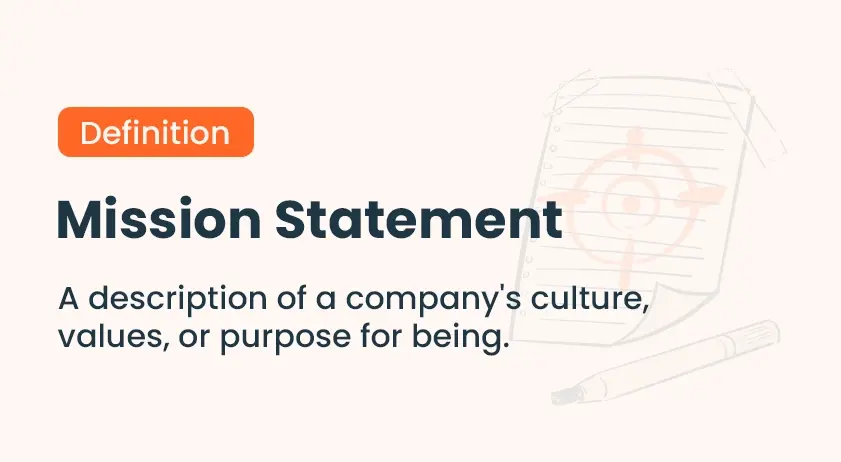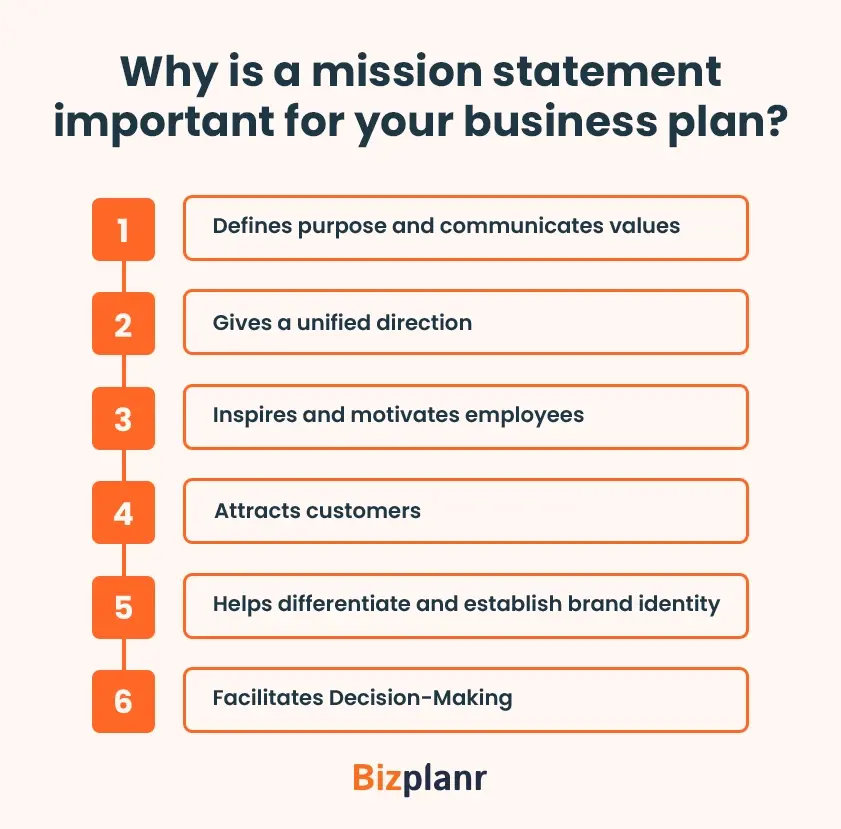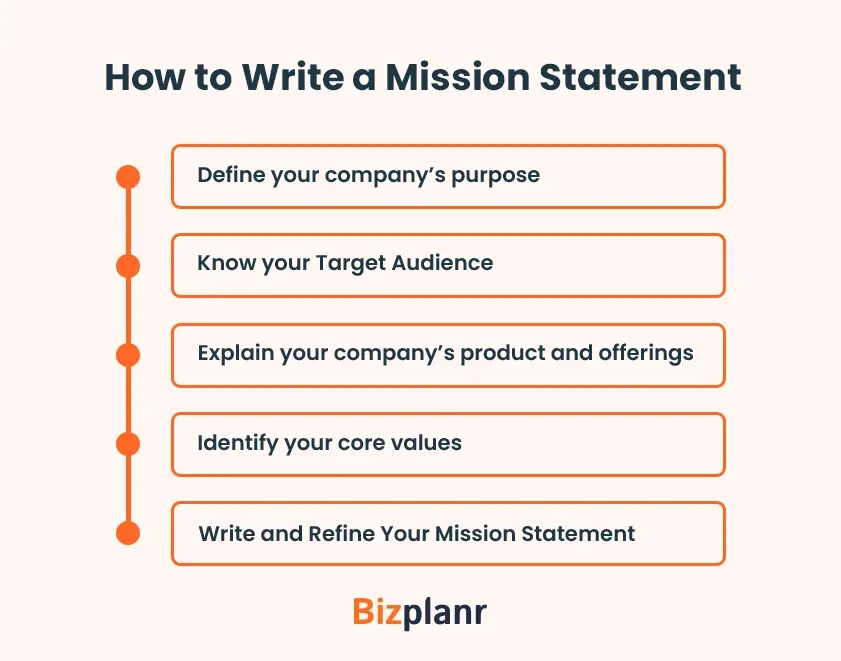- Business Planning

How to Write a Mission Statement for Business Plan + Example

Written by Vinay Kevadiya
Published Sep. 13 2024 · 11 Min Read
Ever noticed how all established and successful brands have a loyal customer base? It’s often because they’re very clear as to what they bring to the table and why the business operates.
And a solid mission statement reflects that generally.
Businesses use mission statements to define their purpose, give a unified direction to their employees, and attract customers—just to name a few. If you’re wondering how to craft an impressive mission statement for your business, you’re at the right place.
In this blog post, we’ll explore the essential steps to writing a compelling mission statement that truly captures the essence of your business.
What is a mission statement?
A mission statement is a clear, concise action-oriented statement that conveys an organization’s purpose and goals. It serves as a guiding principle for better decision-making and ensures that a company’s actions align with its overall objectives.
A good mission statement gives answers to the following:
- Why does your company exist?
- What are the core values that guide your organization?
- What are your primary objectives?
- Who does the organization serve?
It’s important to note that a company’s mission statement may change over time—depending on its growth and evolution. As a company grows, the business owner must revise their mission statement to align with their new goals and values.

Why is a mission statement important for your business plan?
A well-crafted mission statement can help motivate employees, attract potential customers, build company spirit, and develop a strong brand identity.
There are several reasons why you must write a mission statement to include in your business plan such as:

1. Defines purpose and communicates values
A mission statement defines an organization’s purpose, giving direction and focus to its activities. It briefly explains the organization’s reason for existence, what it aims to achieve, and the values it upholds. This helps a business to establish credibility and develop an action plan that aligns with its core values.
2. Gives a unified direction
A mission statement outlines an organization’s purpose and objectives, ensuring everyone is working in a unified direction.
Many times, employees lose focus and question their roles due to stress at the workplace. They can realign themselves to the shared team goals and values by referring to the mission statement.
This clarity helps to prevent distractions and ensures that resources are focused on what truly matters, thus leading to more effective and aligned decision-making.
3. Inspires and motivates employees
Good mission statements inspire and motivate employees by providing a shared sense of purpose. It creates a sense of belongingness and commitment, encouraging individuals to work towards a common goal.
A great mission statement can motivate employees to go beyond their job duties and contribute to something meaningful. This helps in boosting the overall productivity of the company.
4. Attracts customers
Clear and compelling mission statements can attract customers who share the organization’s values and goals.
When potential customers understand what the company stands for and how it aligns with their own beliefs, they’re more likely to be drawn to the brand. This can result in increased customer brand loyalty, positive word-of-mouth, and greater business success.
5. Helps differentiate and establish brand identity
A mission statement differentiates an organization from its competitors, giving it a unique identity and setting it apart in the market. It communicates the organization’s unique value proposition, values, and approach, helping to establish its brand identity and reputation.
6. Facilitates decision making
A mission statement acts as a compass, guiding the organization toward a common goal by ensuring all actions are consistent with its core beliefs and objectives.
It provides a strategic framework for effective decision-making, ensuring that business choices align with its purpose and values. It helps evaluate opportunities, prioritize resources, and make informed decisions that support the organization’s long-term goals.
How to write a mission statement
Writing a compelling and concise mission statement can be a challenging task when you need to ensure that it covers all the important elements.
To simplify it, we’ve explained how to write a mission statement for your business.

1. Define your company’s purpose
The first step in crafting an effective mission statement is identifying and defining your company’s purpose. You must have clarity on the reason for its existence beyond making profits. It’s the impact you want to make in the world.
Ask yourself the following questions:
- What problem do we solve?
- What needs do we fulfill?
- What do we aim to achieve?
For example, Tesla’s purpose is to accelerate the world’s transition to sustainable energy.
While defining your purpose:
- emphasize how your brand differs from others.
- Avoid using generic statements.
- Be a little more specific.
- Communicate your company’s specialty.
For example, a non-woven fabric company might aim to “provide eco-friendly alternatives to plastic packaging.”

2. Know your target audience
Knowing your target audience is crucial when writing a good mission statement. Identify who your organization serves, including customers, clients, or stakeholders. Understand their needs, values, motivations, and expectations. Tailor your mission statement to resonate with them.
By defining your target audience, you can craft an effective mission statement that:
- Speaks to their pain points and aspirations
- Aligns with their values and goals
- Motivates them to support and advocate for your organization
3. Explain your company’s offerings
Clearly describe what you offer to your customers. This includes your products or services, their unique features, and how they benefit your customers.
To do this effectively:
- Identify the pain points of your target audience.
- See how your product or service can help solve their problems.
- Express it in your mission statement.
For example, Warby Parker’s mission is to “inspire and impact the world with vision, purpose, and style”.
Why this a good mission statement:
- Simple and brevity: It is simple and brief
- Inspirational language: Using "inspire" and "impact" creates a sense of aspiration and purpose.
- Memorable: It is easy to catch and easy to remember.
4. Identify your core values
A company’s core values are the fundamental principles that guide your organization’s behavior, decision-making, and culture. They define what matters most to your organization and help shape its identity. For example, innovation, teamwork, sustainability, celebrating human spirit, integrity, etc.
These values ensure your mission statement aligns with your company culture and beliefs.
To identify your company values, consider asking the following questions:
- What beliefs drive your company’s actions?
- What principles do you stand for?
- What values do you want to instill in your team?
- What kind of culture do you aspire to create?
5. Write and refine your mission statement
Combine the elements above into a concise and inspiring statement that captures the essence of your company. A mission statement can be 3 sentences or more, depending on how big your organization is and what it aims to accomplish.
During the mission statement writing process, consider the “what,” “why,” and “how” of your company:
What – product or service are you selling?
Why – are you selling? (primary objective)
How – is your product helpful to your customers?
Make sure your mission statement is clear, memorable, and aligned with your overall goals.
Take the help of your team members and spend ample time crafting an impactful mission statement. Once you’re done with your first draft, revise and refine it to make it crisp and clear. Remove any fluff and tweak the language to ensure it resonates with your stakeholders.
3 Additional tips for writing the best mission statements
Below are a few additional tips that will make your business mission statement more effective.
1) Be concise
Keep it brief and impactful. Aim for a mission statement under 150 words, using clear and direct language to convey your purpose. This makes it easily digestible, memorable, and effective in communicating your company’s vision and goals.
Further, eliminate unnecessary words or overused phrases such as “being the best possible”, “world-class” etc. They sound very generic and unnecessarily add to the word count.
2) Think from a long-term perspective
Envision where you want your organization to be in 5-10 years and ask yourself:
- What impact do you want to make?
- What values do you wish to uphold?
- What legacy do you want to create?
This forward-thinking approach will help you craft a business mission statement that’s enduring and guides your company’s decisions and actions for years to come.
3) Bring inspiration
Add an emotional appeal. Incorporate words or phrases that evoke emotions, creating a personal or human connection with your audience.
The easiest way to do so is to display passion. Show your enthusiasm in your mission statement, what drives you, and why you love what you’re doing.
That said, let’s move on to...
Mission statement examples
Here are some real-life company mission statement examples from popular giants:
To organize the world’s information and make it universally accessible and useful.
Google’s mission statement is great because it has the following elements:
- Clarity: Easy to understand and concise
- Purpose: Aims to make a significant impact globally
- Focused: Concentrates on information and accessibility
- Inspiring: Empowers individuals and advances knowledge
Overall, Google’s mission statement effectively communicates the company’s purpose, guiding its innovations and services and resonating with users worldwide.
2. Microsoft
To empower every person and every organization on the planet to achieve more.
Some statements speak volumes in very few words. Microsoft’s mission statement is one such example. It reflects the company’s goal to make a positive difference globally.
Why it’s a good statement:
- Inclusive language: "Every person" and "every organization" makes the statement inclusive and universal.
- Empowering: emphasizes enabling individuals and organizations to reach their full potential.
- Positive and uplifting tone: The statement conveys a sense of optimism and possibility.
3. American Express
“To become essential to our customers by providing differentiated products and services to help them achieve their aspirations.”
American Express has a strong mission statement that shows they’re a customer-centric company that places high emphasis on carrying an element of differentiation. This is a good one because the mission statement focuses on:
- Customer needs: Prioritizes helping customers achieve their aspirations
- Differentiation: Commits to offering distinct and valuable products and services
- Setting a high standard: Aims to be essential, not just useful
American Express’ mission statement conveys a customer-centric approach, driving innovation and excellence for creating meaningful relationships that last long with its customers.
Make work life simpler, more pleasant, and more productive.
We can see that Slack’s clear mission statement highlights three key goals: simplifying communication, improving user experience, and boosting productivity.
This makes it a strong and concise statement because it directly addresses the needs of its target audience—businesses and professionals seeking effective collaboration tools. By focusing on simplicity, enjoyment, and efficiency, it resonates with users, making it easy to understand and memorable.
To devote our human resources and technology to creating superior products and services that contribute to a better global society.
This is a powerful business mission statement because it emphasizes the company’s commitment to both innovation and social impact.
By focusing on “human resources and technology”, it highlights the importance of skilled people and advanced solutions in driving progress. The aim to create “superior products and services” underscores their pursuit of quality and customer satisfaction.
Furthermore, the goal of contributing to a “better global society” reflects a broader company vision, displaying a sense of responsibility beyond profit.
A well-crafted mission statement isn’t merely a tagline; it’s a guiding light for your company. It defines your purpose, outlines your values, and inspires your team.
By following the steps explained in this article, you can create an impactful mission statement that resonates with your audience and establishes your brand identity. That said, we know it’s not as simple as it may sound. If you’re feeling stuck, try Bizplanr . Its AI can whip up a business plan containing the perfect mission statement for you in a jiffy.
Get Your Business Plan Ready In Minutes
Answer a few questions, and AI will generate a detailed business plan.
Generate your Plan
Frequently Asked Questions
What are the key elements of a strong mission statement?
The key elements of a successful mission statement include:
- Purpose: The reason why your business exists
- Values: A company’s culture, core values, and beliefs
- Target audience: specific group of people, customers, or communities that the organization aims to serve.
- Product/service: What a company is selling and how it benefits the user
- Unique Selling Proposition (USP): How your company is different from its competitors.
How often should you update your mission statement?
Generally, mission statements need updating every 3-5 years to ensure relevance, accuracy, and alignment with your values. However, it depends on various factors, such as your company’s growth, changes in its goals, shifts in the industry, etc.
How long should a mission statement be?
Ideally, it should be between one and three sentences. And no more than 100 words. A shorter mission statement is memorable, easier to communicate, and more appealing to customers.
What are the common mistakes to avoid when writing a mission statement?
Here are a few things to avoid to create a well-written mission statement for your own business:
- Using vague language: avoid using broad, generic language with no clear purpose, as it can confuse your readers.
- Having Unrealistic goals: this can make your company lose its credibility.
- Making it too long or complex: lengthy or overly complicated statements may not have the desired impact on your audience.

As the founder and CEO of Upmetrics, Vinay Kevadiya has over 12 years of experience in business planning. He provides valuable insights to help entrepreneurs build and manage successful business plans.
Follow Vinay Kevadiya
Related Articles

How to Write a Company Overview for a Business Plan

How to Write an Internal Business Plan

How to Format a Business Plan

IMAGES
VIDEO
COMMENTS
How Do You Write a Mission Statement? When creating an outline for your mission statement, there are four steps to follow, each of which will help you craft the strongest, clearest...
How to Write an Effective Mission Statement in 3 Steps. Whether you're a small business owner or the chairman of a Fortune 500 company, you’ve probably thought about why you do what you do. If you're serious about your business, it’s because you have a sense of mission.
A mission statement is a simple action-oriented statement that explains your company’s purpose. It summarizes what your company does for customers, employees, and owners, and typically includes general descriptions of your organization, its core function, and its goals.
Updated: Jun 28, 2024, 6:32am. Editorial Note: We earn a commission from partner links on Forbes Advisor. Commissions do not affect our editors' opinions or evaluations. Getty. Table of Contents....
If you’re wondering how to craft an impressive mission statement for your business, you’re at the right place. In this blog post, we’ll explore the essential steps to writing a compelling mission statement that truly captures the essence of your business.
Learn how to write a business mission statement with these powerful mission statement examples—plus free, easy-to-use templates!